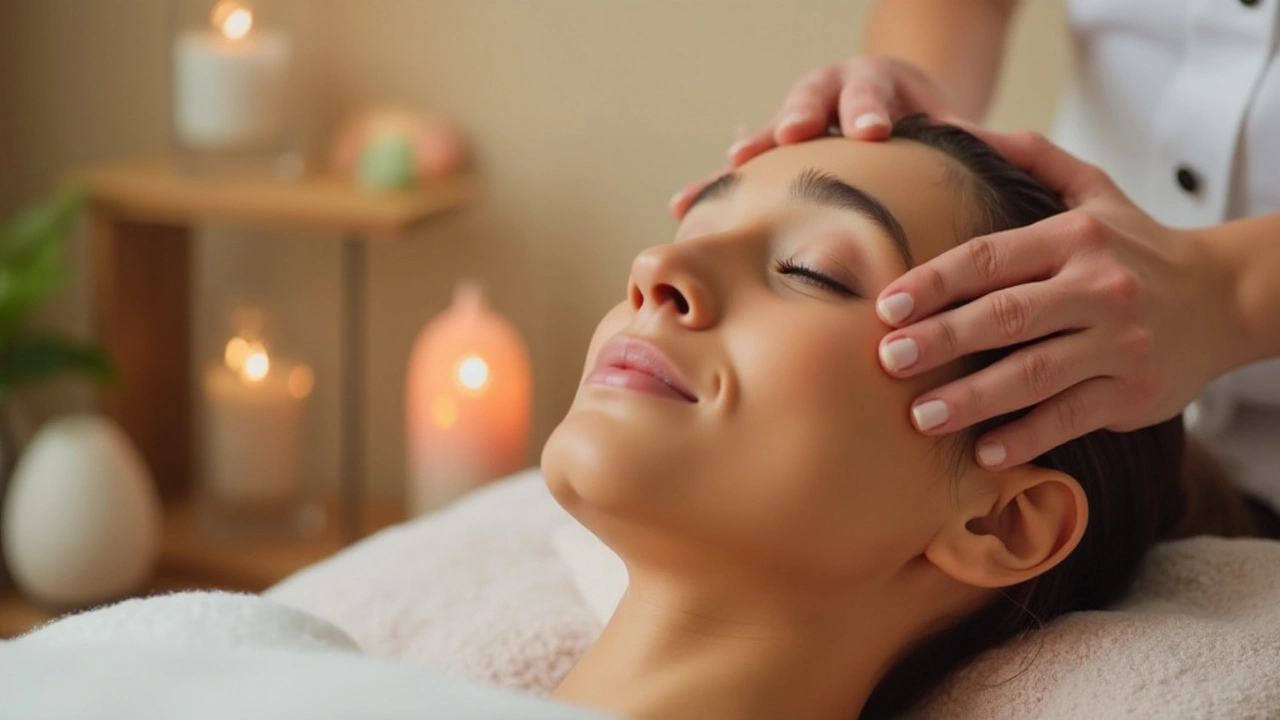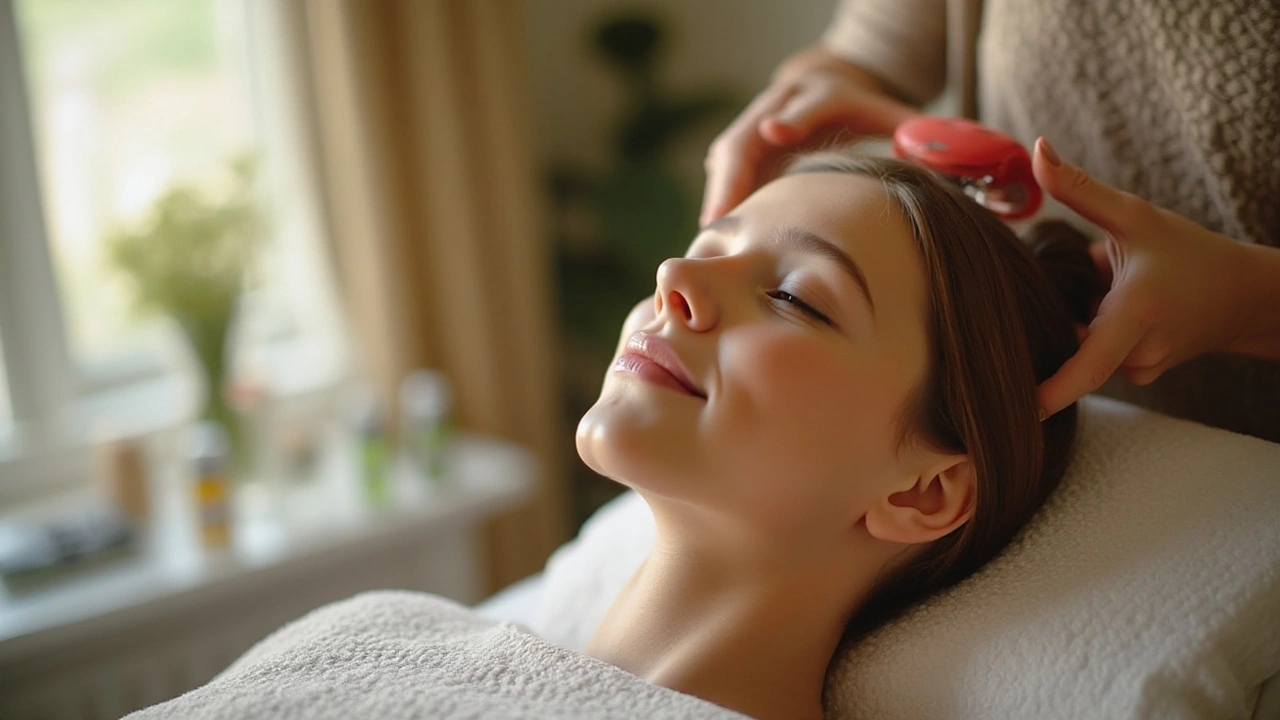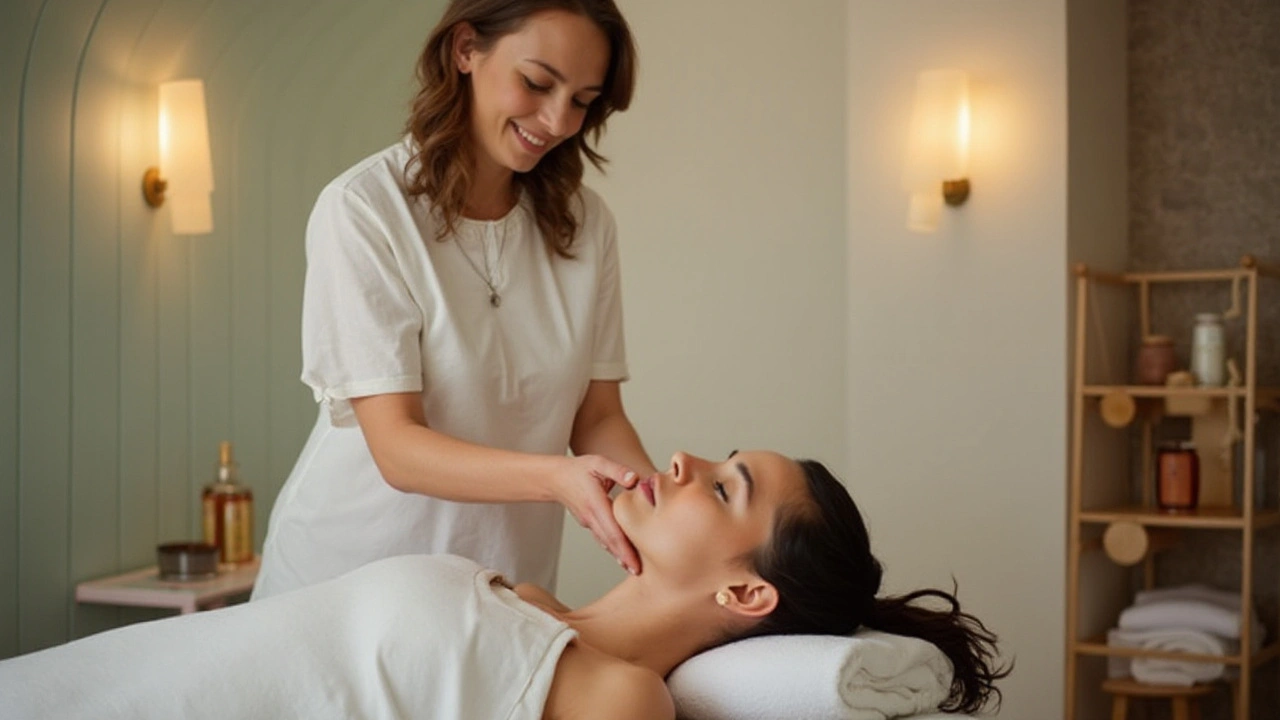Experiencing your first head and scalp massage can be both exciting and a bit nerve-wracking. Knowing what to expect can help ease any anxiety and allow you to fully relax into the experience.
Head and scalp massages are not only incredibly relaxing, but they also have numerous benefits for your mental and physical well-being. From reducing stress to improving hair health, there's a lot to look forward to.
In this guide, we'll explore what happens during a head and scalp massage and how you can get the most out of your session. From preparation tips to post-massage care, everything you need to know is right here.
- Understanding Head and Scalp Massage
- The Benefits You Didn't Know About
- How to Prepare for Your Session
- What Happens During the Massage
- Tips to Enhance Your Experience
- Post-Massage Care and Effects
Understanding Head and Scalp Massage
Head and scalp massage is a therapeutic technique that involves gentle and rhythmic manipulation of the muscles and tissues of your head and scalp. This form of massage fosters relaxation, relieves tension, and has a multitude of health benefits. The roots of head and scalp massage can be traced back to ancient cultures, where it was a common practice to enhance well-being and spiritual balance.
A typical head and scalp massage session often starts with the therapist using their fingertips to apply light pressure in circular motions. This helps to stimulate blood circulation, which can lead to numerous health benefits, including improved hair growth and a reduction in headaches. One of the primary reasons many people seek out head and scalp massages is because it effectively alleviates stress. The gentle touch communicates a sense of reassurance, making it a popular choice for those looking to unwind.
Another significant advantage of head and scalp massages is their ability to improve focus and mental clarity. According to a study published in the International Journal of Neuroscience, regular head massages can enhance mood and cognitive function by boosting endorphin levels in the brain. It’s no wonder then that many people incorporate this treatment into their self-care routine.
Scalp massage benefits extend to the hair as well. Increased blood flow to the scalp can promote healthier hair follicles, resulting in stronger, shinier hair over time. Some techniques even incorporate the use of essential oils like lavender or rosemary, which are believed to offer additional therapeutic benefits. Always be sure to communicate with your therapist about any allergies you might have before your session begins.
"A head and scalp massage can significantly reduce symptoms of anxiety and depression, making it an invaluable treatment for mental health." - Journal of Alternative and Complementary Medicine
For those new to this form of massage, it’s essential to know that discomfort should not be part of the experience. The pressure applied is usually light to moderate, and you should always feel free to speak up if the pressure needs adjusting. It's your session, and the goal is to make you feel as comfortable and relaxed as possible.
Lastly, various tools are sometimes employed during a head and scalp massage. Some practitioners might use massage brushes or handheld devices designed to mimic human touch. These tools can add another layer of stimulation, enhancing the overall experience and providing deeper relaxation. Whether you choose a traditional manual massage or one that incorporates tools, the benefits are noteworthy.
The Benefits You Didn't Know About
Getting a head and scalp massage goes beyond just feeling good. This type of massage offers a range of benefits that you might not be aware of. It can improve your mental and physical health in several surprising ways. One of the most talked-about benefits is stress relief. When a professional massages your scalp, it stimulates nerve endings, which in turn can lead to the release of endorphins and serotonin. These chemicals are natural mood enhancers, making you feel happier and more relaxed.
Improving blood circulation is another significant benefit. A good scalp massage increases blood flow to the head and neck area. This not only helps in muscle relaxation but also aids in the nourishment of hair follicles, which can promote healthier and stronger hair growth. If you struggle with headaches or migraines, a head massage can sometimes offer relief. By focusing on tension points and increasing blood flow, the massage can help reduce the frequency and intensity of headaches.
Another lesser-known benefit is the improvement in focus and mental clarity. By relieving tension in the head, neck, and shoulders, a scalp massage helps in promoting better concentration and reducing brain fog. This can be especially useful for those with high-stress jobs or students preparing for exams. A quote from Dr. Sarah Brewer, a natural health expert, encapsulates these benefits: "The gentle manipulation of the scalp can trigger a cascade of biochemical reactions, leading to improved mood, better sleep quality, and enhanced focus."
Don’t overlook the potential skin benefits either. Scalp massages can help exfoliate the scalp skin, removing dead skin cells and promoting a healthier scalp environment. This can be particularly beneficial for people who suffer from scalp conditions like dandruff or psoriasis. By keeping the scalp clean and well-nourished, a massage can also reduce dryness and itching. Additionally, the oil used during the massage provides an extra layer of moisture and can be tailored to your specific scalp needs, whether it’s dryness, oiliness, or sensitivity.
Believe it or not, a good head and scalp massage can also have respiratory benefits. By massaging certain pressure points, it can help in opening nasal passages and improving breathing. This can be particularly helpful during allergy season or if you're experiencing a cold. Plus, the relaxation induced by the massage can improve sleep quality, yet another way it indirectly benefits your health.
Lastly, there are social benefits to consider. Many people find that getting a head and scalp massage helps them feel more connected to their bodies. It can serve as a meditative experience, helping to ground you and bring you back into the present moment. This can be useful for anyone practicing mindfulness or seeking to improve their mental well-being. Whether you're dealing with stress, cognitive overload, or physical aches, a head and scalp massage offers a wide range of benefits you might not have considered before.

How to Prepare for Your Session
Getting ready for a head and scalp massage can make a big difference in how much you enjoy and benefit from the experience. It's not just about showing up; a little preparation can help you relax more deeply and get the most from your session. Here are a few tips to help you prepare effectively.
First off, it’s important to choose the right time for your massage. You'll want to pick a time when you won't be rushed before or after. This will help you to fully relax and enjoy the session without feeling pressed for time. Many find that booking a session in the late afternoon or evening works well, as it can be a great way to unwind from the day.
Remember to wash your hair beforehand if possible. Clean hair makes it easier for the therapist to work on your scalp, and you'll feel fresher too. However, avoid using too many hair products such as gels or sprays as these can make the scalp harder to massage. Keep it simple and clean for the best experience.
It's also a good idea to hydrate before your session. Drinking water helps keep your body in good condition and makes it easier to flush out any toxins released during the massage. According to experts, staying hydrated can also improve how your skin and scalp respond to the massage techniques.
Avoid eating a heavy meal right before your appointment. Eating too much can make you feel uncomfortable during the session. Opt for a light snack if you're hungry, but try to have your main meal well before your appointment time. This way, your body can focus on relaxation rather than digestion.
Wearing comfortable clothes is another useful tip. You might want to wear something loose around the neck and shoulders to make it easier for the therapist to access those areas. Some spas may ask you to change into a robe, but comfortable clothing will help you stay relaxed before and after the session.
Don't hesitate to communicate your needs and preferences with your therapist before the session starts. Whether you prefer gentle or firm pressure, or if there are any areas you want them to focus on or avoid, letting them know in advance can significantly enhance your experience. Communication is key to getting exactly what you need from your massage.
Turn off your phone or put it on silent to avoid any interruptions. This time is for you to relax and unwind. Minimizing distractions will help you fully immerse yourself in the therapeutic experience. After all, the primary goal of a head and scalp massage is to reduce stress and promote relaxation.
Lastly, try to arrive a little early for your appointment. Arriving early gives you the chance to settle in, complete any necessary forms, and start to relax before your session even begins. It’s a small step that can make a big difference in how relaxed you feel during your massage.
What Happens During the Massage
When you first arrive for your head and scalp massage, the therapist will usually ask a few questions to understand any specific needs or preferences you have. They might inquire about areas of tension or discomfort and any previous experiences with massage. This helps them tailor the session to your particular needs.
You’ll then be invited to relax in a comfortable chair or lie down on a massage table. Soft, calming music often plays in the background to help set the mood. The therapist may use essential oils or massage oils for added relaxation and nourishment of the scalp. Lavender and peppermint are popular choices due to their calming and invigorating properties, respectively.
The therapist will start with gentle touches to help you relax and slowly increase pressure as needed. Techniques used in a head and scalp massage can vary widely. Common methods include gentle kneading, tapping, and circular strokes. The goal is to stimulate blood flow and relieve any muscular tension. Some therapists might also incorporate acupressure or reflexology techniques, which involve applying pressure to specific points on the scalp to promote overall healing.
One fascinating aspect of head and scalp massages is their ability to release endorphins, the body's natural feel-good chemicals, which help to alleviate stress and improve mood. According to the American Massage Therapy Association, 'Regular head massages can significantly decrease symptoms of anxiety and depression.' These sessions often last between 30 to 60 minutes. Though it might not sound long, it’s usually sufficient to provide a deep sense of relaxation and well-being.
As the therapist works through the massage, you may feel various sensations ranging from light tingles to intensive relaxation waves. It’s entirely normal to even drift off to sleep during the session – which many consider the ultimate form of endorsement. Dreamy relaxation is sometimes the body's natural response to such care and attention.
The massage may also include the neck and shoulders, as tensions in these areas can often contribute to scalp stiffness. The connection between these areas means that relieving one can often help relax the other.
To maximize the benefits of your session, it's helpful to communicate with your therapist throughout. If something feels particularly good or if the pressure is too much, let them know. They’re there to provide a comfortable, healing experience tailored to you.
At the session's end, it’s common to feel dazed or incredibly relaxed. Take your time to rise slowly and perhaps enjoy a glass of water before leaving. The therapist may offer you some aftercare tips to extend the effects of the massage, like staying hydrated and avoiding vigorous activity for the rest of the day.

Tips to Enhance Your Experience
Getting the most out of your first head massage takes a bit of preparation and an open mind. One of the best ways to enhance your experience is by arriving at your appointment early. This gives you the chance to settle into the environment, reducing any lingering stress from a hurried arrival. It's much easier to relax when you're not rushing and have a moment to breathe and mentally prepare for the relaxation ahead.
Another important tip is open communication with your massage therapist. Don't hesitate to share any preferences or concerns you might have. Whether you prefer a lighter touch or a more vigorous scalp rub, your therapist can tailor the massage to suit your needs. Clear communication ensures that you’re comfortable throughout the session and that you get the kind of relief you're looking for.
Bringing a positive mindset to the session can also make a world of difference. Try to let go of any stress or worries before the massage starts. This mental shift can enhance the benefits of the massage, allowing you to leave the session feeling truly refreshed. A positive attitude can amplify the relaxation effects and make the experience more enjoyable.
Many experts recommend staying hydrated before and after your massage. Drinking water helps to flush out the toxins that a massage can release into your system. Not staying hydrated can lead to feelings of sluggishness or a mild headache after the session, which can detract from the overall benefits.
For those looking to maximize the benefits of their scalp massage, consider incorporating some essential oils. Lavender and peppermint oils are great choices, as they can enhance relaxation and provide a tingling sensation that many find soothing. Be sure to check with your massage therapist beforehand to ensure they're comfortable with using oils, and to avoid any possible allergic reactions.
After the massage, take your time getting up. Your body has just experienced deep relaxation and might not react well to sudden movements. Slowly sitting up and taking a few moments to adjust can prevent dizziness and maintain the sense of calm the massage has introduced.
Another post-massage tip is to avoid strenuous activities immediately after. Give your body a bit of time to enjoy the relaxed state it's in. If possible, plan your massage for a day when you can go home and continue to unwind. Light stretching or a warm bath post-massage can also help to maintain the relaxed feeling.
Don't forget to follow any aftercare advice provided by your therapist. They might recommend specific stretches or hydration tips to extend the benefits of the session. Each individual's needs can vary, so personalized advice from a professional is invaluable.
By considering these tips, you can enhance the benefits of your first head and scalp massage. A bit of preparation, an open mind, and proper aftercare can transform a simple massage session into a rejuvenating experience that offers lasting benefits to both your body and mind.
Post-Massage Care and Effects
After enjoying a blissful head and scalp massage, your journey to rejuvenation doesn't end when you leave the massage table. Taking time to care for yourself post-massage can prolong the benefits and enhance your overall experience. One of the first things you'll notice is a sense of deep relaxation. This is your body’s way of telling you it appreciated the care and attention. Allow yourself some time to fully come back to reality before jumping back into your daily routine.
It's common to feel slightly light-headed, so ensure you rise slowly and drink plenty of water to rehydrate. Massage stimulates your circulatory system, which helps remove toxins from your body. Drinking water helps flush these out and keeps you feeling refreshed. If you feel the urge to nap, listen to your body. A short rest can help you fully absorb the positive effects of the massage.
Your hair may appear a bit flat or oily due to the massage oils used. It's usually beneficial to leave these oils in for a few hours or overnight as they nourish your scalp and hair. If necessary, wear a loose-fitting hat or scarf to protect your styling until you're able to wash. Hair health aside, mentally you might feel more focused and clear-headed. This is often due to the release of tension and stimulation of pressure points on your head and scalp.
According to a study by the International Journal of Therapeutic Massage & Bodywork, regular head massages can improve mood and general well-being.
“This kind of massage not only helps in physical relaxation but also significantly reduces stress, anxiety, and depression after just a single session.”
To get the maximum benefits, consider establishing a routine. Monthly sessions could keep stress at bay and boost your mood over time. Observe how you feel in the days following your first massage. While some people experience immediate relief, others might notice benefits accumulating with regular sessions.
In some cases, you might experience mild soreness or tenderness in the areas that were massaged. This is generally normal and should subside within a day or two. Using a warm compress on these areas can offer some relief. Gentle stretching and maintaining good posture can also contribute to the longevity of the massage’s effects.
Lastly, incorporate relaxation techniques like deep breathing or light meditation to extend the serene state induced by the massage. Creating a calming environment at home with soft music or aromatherapy can help maintain this peaceful feeling. By following these care tips, you will harness the full potential of your head and scalp massage, turning a single session into a long-lasting journey toward holistic well-being.


 Health and Wellness
Health and Wellness